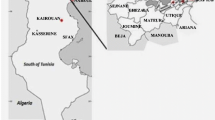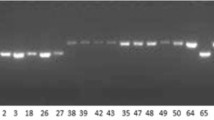Abstract
In more than 60 families of angiosperms, the self- and cross-fertilization is avoided through a complex widespread genetic system called self-incompatibility (SI). One of the major puzzling issues concerning the SI is the evolution of this system in species with complex polyploid genomes. Among plums, one of the first fruits species to attract human interest, polyploid species represent enormous genetic potential, which can be exploited in breeding programs. However, molecular studies in these species are very scarce due to the complexity of their genome. In order to study the SFB gene [the male component of gametophytic self-incompatibility system (GSI)] in plum species, 36 plum accessions belonging to diploid and hexaploid species were used. A total of 19 different alleles were identified; 1 of them was revealed after analyzing sequences. Peptide sequence analysis allowed identifying the five domains features of the SFB gene. Polymorphism analysis showed a subtle difference between domesticated and open pollinated Tunisian accessions and suggested a probable influence of the ploidy level. Divergence analysis between studied sequences showed that a new specificity may appear after 5.3% of divergence at synonymous sites between pairs of sequences in Prunus insititia, 6% in Prunus cerasifera, 8% and 9% in Prunus domestica and Prunus salicina respectively. Furthermore, sites under positive selection, the ones more likely to be responsible for specificity determination, were identified. A positive and significant Pearson correlation was found between the divergence between sequences, divergence time, fixed substitutions (MK test), and PSS number. These results supported the model assuming that functionally distinct proteins have arisen not as a result of chance fixation of neutral variants, but rather as a result of positive Darwinian selection. Further, the role that plays recombination can not be ruled out, since a rate of 0.08 recombination event per polymorphic sites was identified.




Similar content being viewed by others
Data Availability
The data sets supporting this article have been uploaded as part of the Supporting Information. The nucleotide sequence data of the SFB gene for Prunus species were deposited in the GeneBank nucleotide sequence databases with the accession numbers KU728959–KU728994.
Abbreviations
- Bs:
-
Bootstrap value
- C :
-
Conservation level between nucleotide sequences
- GSI:
-
Gametophytic self-incompatibility system
- K A :
-
Divergence between alleles at non-synonymous sites
- K S :
-
Divergence between alleles at synonymous sites
- MK:
-
McDonald and Kreitman test
- Myr:
-
Million years
- P A :
-
Polymorphism at non-synonymous sites
- P S :
-
Polymorphism at synonymous sites
- PSS:
-
Positively selected sites
- R m :
-
Minimum number of recombination
- R NS :
-
Rate of new specificity appearance
- SFB:
-
S-haplotype-specific F-box
- SI:
-
Self-incompatibility system
- S-RNase:
-
S-Ribonuclease
- T div :
-
Divergence time
References
Abdallah D, Baraket G, Ben Tamarzizt H, Ben Mustapha S, Salhi-Hannachi A (2016) Identification, evolutionary patterns and intragenic recombination of the gametophytic self incompatibility pollen gene (SFB) in Tunisian Prunus species (Rosaceae). Plant Mol Biol Rep 34:339–352
Abdallah D, Baraket G, Perez V, Ben Mustapha S, Salhi Hannachi A, Hormaza I (2019) Analysis of self-incompatibility and genetic diversity in diploid and hexaploid plum genotypes. Front Plant Sci. https://doi.org/10.3389/fpls.2019.00896
Aguiar B, Vieira J, Cunha AE, Fonseca NA, Iezzoni A, van Nocker S et al (2015) Convergent evolution at the gametophytic self-incompatibility system in Malus and Prunus. PLoS ONE 10:e0126138
Akagi T, Henry IM, Morimoto T, Tao R (2016) Insights into the Prunus-specific S-RNase-based self-incompatibility system from a genome-wide analysis of the evolutionary radiation of S locus-related F-box genes. Plant Cell Physiol 57(6):1281–1294
Bonferroni CE (1936) Teoriastatisticadelleclassi e calcolodelleprobabilità. Pubbl R Ist Super Sci Econ Commer Firenze 8:3–62
Botu M, Sarpe C, Cosmulescu S (2002) The genetic control of pollen fertility, pollinizing and fruit set for the Prunus domestica L. plum cultivars. Acta Hortic 577:139–145
Castric V, Vekemans X (2004) Plant self-incompatibility in natural populations: a critical assessment of recent theoretical and empirical advances. Mol Ecol 13:2873–2889
Charlesworth D, Vekemans X, Castric V, Glemin S (2005) Plant self-incompatibility systems: a molecular evolutionary perspective. N Phytol 168:61–69
Das B, Ahmed N, Singh P (2011) Prunus diversity–early and present development: a review. Int J Biodivers Conserv 14:721–734
De Candolle A (1964) Origin of cultivated plants. Hafner Publ. Co., New York
De Nettancourt D (2001) Incompatibility and incongruity in wild and cultivated plants, 2nd edn. Springer, Berlin
Decroocq V, Hagen LS, Favé MG, Eyquard JP, Pierronnet A (2004) Microsatellite markers in the hexaploid Prunus domestica species and parentage lineage of three European plum cultivars using nuclear and chloroplast simple-sequence repeats. Mol Breed 13:135–142
Doyle JJ, Doyle JL (1987) Isolation of DNA from fresh plant tissue. Focus 12:13–15
Entani T, Iwano M, Shiba H, Che FS, Isogai A, Takayama S (2003) Comparative analysis of the self-incompatibility (S-) locus region of Prunus mume: identification of a pollen-expressed F-box gene with allelic diversity. Genes Cells 8:203–213
Fisher RA (1929) Tests of significance in harmonic analysis. Proc R Soc Lond A 125(796):54–59
Gu C, Lu W, Korban SS, Han Y (2015) Identification and characterization of S-RNase genes and S-genotypes in Prunus and Malus species. Can J Plant Sci 95:1–13
Halász J, Kurilla A, Hegedûs A (2014) Preliminary characterization of the self-incompatibility genotypes of European plum (Prunus domestica L.) cultivars. Int J Hortic Sci 20:23–26
Halász J, Makovics-Zsoha N, Szöke F, Ercilis S, Hegedüs A (2017) Simple sequence repeat and S-locus genotyping to explore genetic variability in polyploid Prunus spinosa and P. insititia. Biochem Genet 55:22–33
Hammer O, Harper DAT, Ryan PD (2001) PAST: paleontological statistics software package for education and data analysis. Palaeontol Electron 4(1):1–9
Hammer LB, Kossek EE, Yragui NL, Bodner TE, Hanson GC (2009) Development and validation of a multidimensional measure of family support supervisor behaviors (FSSB). J Manag 35:837–856
Hudson RR, Kreitman M, Aquadé M (1987) A test of neutral molecular evolution based on nucleotide data. Genetics 116:153–159
Ikeda K, Igic B, Ushijima K, Yamane H, Hauck NR, Nakano R, Sassa H, Iezzoni AF, Kohn JR, Tao R (2004) Primary structural features of the S haplotype-specific F-box protein, SFB, in Prunus. Sex Plant Reprod 16:235–243
Jukes TH, Cantor CR (1969) Evolution of protein molecules. In: Munro H (ed) Mammalian protein metabolism. Academic, New York, pp 21–32
Kato S, Mukai Y (2004) Allelic diversity of S-RNase at the self-incompatibility locus in natural flowering cherry populations (Prunus lannesiana var. speciosa). Heredity 92:249–256
Kota-Dombrovska I, Lâcis G (2013) Evaluation of self-incompatibility locus diversity of domestic plum (Prunus domestica L.) using DNA-based S-genotyping. Proc Latv Acad Sci B 67(2, 683):109–115.
Kumar S, Gadagkar SR (2001) Disparity Index: a simple statistic to measure and test the homogeneity of substitution patterns between molecular sequences. Genetics 158:1321–1327
McCubbin AG, Wang X, Kao T-H (2000) Identification of self-incompatibility (S-) locus linked pollen cDNA markers in Petunia inflata. Genome 43:619–627
Mcdonald JH, Kreitman M (1991) Adaptive protein evolution at the Adh locus in Drosophila. Nature 351:652–654
Mestre L, Reig G, Betrán J, Moreno MA (2017) Influence of plum rootstocks on agronomic performance, leaf mineral nutrition and fruit quality of ‘Catherina’ peach cultivar in heavy-calcareous soil conditions. Span J Agric Res 15(1):e0901
Nei M, Gojobori T (1986) Simple methods for estimating the numbers of synonymous and nonsynonymous nucleotide substitutions. Mol Biol Evol 3:418–426
Nei M, Kumar S (2000) Molecular evolution and phylogenetics. Oxford University Press, New York
Nunes MDS, Santos RAM, Ferreira SM, Vieira J, Vieira CP (2006) Variability patterns and positively selected sites at the gametophytic self-incompatibility pollen SFB gene in a wild self-incompatible Prunus spinosa (Rosaceae) population. N Phytol 172:577–587
OECD (2002) Consensus Document on the Biology of Prunus spp. (Stone fruits), vol 1. Environment Directorate, OECD, Paris, p 42
Ortega E, Bošković R, Sargent DJ, Tobutt KR (2006) Analysis of S-RNase alleles of almond (Prunus dulcis): characterization of new sequences, resolution of synonyms and evidence of intragenic recommendation. Mol Gen Genet 276:413–426
Reig G, Jiménez S, Mestre L, Font iForcada C, Betrán JA, Moreno MA (2018) Horticultural, leaf mineral and fruit quality traits of two ‘Greengage’ plum cultivars budded on plum based rootstocks in Mediterranean conditions. Sci Hortic 232:84–91
Rozas J, Sánchez-del Barrio JC, Messeguer X, Rozas R (2003) DnaSP, DNA polymorphism analysis and other methods. Bioinformatics 19:2496–2497
Rzhetsky A, Nei M (1992) A simple method for estimating and testing minimum evolution trees. Mol Biol Evol 9:945–967
Saitou N, Nei M (1987) The neighbor-joining method: a new method for reconstructing phylogenetic trees. Mol Biol Evol 4:406–425
Sassa H (2016) Molecular mechanism of the S-RNase-based gametophytic self-incompatibility in fruit trees of Rosaceae. Breed Sci 66:116–121
Sawyer SA, Hartlt DL (1992) Population genetics of polymorphism and divergence. Genetics 132:1161–1176
Tamura K, Stecher G, Peterson D, Filipski A, Kumar S (2013) MEGA6: Molecular Evolutionary Genetics Analysis version 6.0. Mol Biol Evol 30:2725–2729
Thompson J, Gibson TJ, Plewniak F, Jeanmougin F, Higgins DG (1997) The ClustalX window interface: flexible strategies for multiple sequence alignment aided by quality analysis tools. Nucleic Acids Res 25:4876–4882
Ushijima K, Sassa H, Tao R, Yamane H, Dandekar AM, Gradziel TM, Hirano H (1998) Cloning and characterization of cDNAs encoding S-RNases from almond (Prunus dulcis): analysis of a somaclonal mutant and a cosmid contig for an S haplotype. Genetics 158:771–781
Ushijima K, Sassa H, Dandekar AM, Gradziel TM, Tao R, Hirano H (2003) Structural and transcriptional analysis of the self-incompatibility locus of almond: identification of a pollen expressed F-box gene with haplotype-specific polymorphism. Plant Cell 15:771–781
Uyenoyama MK (1997) Genealogical structure among alleles regulating self-incompatibility in natural populations of flowering plants. Genetics 147:1389–1400
Vieira J, Ferreira PG, Aguiar B, Fonseca NA, Vieira CP (2010) Evolutionary patterns at the RNase based gametophytic self-incompatibility system in two divergent Rosaceae groups (Maloideae and Prunus). BMC Evol Biol 10:200
Vieira J, Fonseca NA, Santos RAM, Habu T, Tao R, Vieira CP (2008a) The number, age, sharing and relatedness of S-locus specificities in Prunus. Genet Res 90:17–26
Vieira J, Teles E, Santos RAM, Vieira CP (2008b) Recombination at Prunus S-locus region SLFL1 gene. Genetics 180:483–491
Vieira CP, Charlesworth D, Vieira J (2003) Evidence for rare recombination at the gametophytic selfincompatibility locus. Heredity 91:262–267
Wright S (1939) The distribution of self-sterility alleles in populations. The University of Chicago, Chicago
Xia X, Xie Z (2001) DAMBE: software package for data analysis in molecular biology and evolution. J Hered 92:371–373
Zeng B, Wang J, Hao Q, Yu Z, Abudukayoumu A, Tang Y, Zhang X, Ma X (2019) Identification of a novel SBP1-containing SCF SFB complex in wild dwarf almond (Prunus tenella). Front Genet 10:1019
Zhang H, Kitashiba N (2007) Identification of S-haplotype-specific F-box gene in Japanese plum (Prunus salicina Lindl). Sex Plant Reprod 20:1–8
Acknowledgements
The authors would like to gratefully thank ‘Sodon collection’ (Bou-Selem, Tunisia), Tunisian farmers and the ‘EEAD-CSIC Prunus bank germplasm’ (Zaragoza, Spain) for kindly providing plant material. We gratefully acknowledge V. Guajardo for critical review of the manuscript.
Funding
This research was supported by the Tunisian ‘Ministère de l’Enseignement supérieur et de la Recherche Scientifique’ and the Project PCI ref. AP/038338/11, funded by the ‘Agencia Española de Cooperación Internacional para el Desarrollo-AECID’of the Spanish Ministry of Foreign Affairs and Cooperation.
Author information
Authors and Affiliations
Contributions
DA performed the experiments and statistical analyses, developed the genetic analyses and wrote the manuscript. GB provided some plant material, discussed and corrected the content. SBM developed some molecular tests. MAM and ASH offered experimental instructions, supervised and provided editorial advice.
Corresponding author
Ethics declarations
Conflict of interest
The authors declare that they have no conflict of interest.
Additional information
Publisher's Note
Springer Nature remains neutral with regard to jurisdictional claims in published maps and institutional affiliations.
Electronic supplementary material
Rights and permissions
About this article
Cite this article
Abdallah, D., Baraket, G., Ben Mustapha, S. et al. Molecular and Evolutionary Characterization of Pollen S Determinant (SFB Alleles) in Four Diploid and Hexaploid Plum Species (Prunus spp.). Biochem Genet 59, 42–61 (2021). https://doi.org/10.1007/s10528-020-09990-x
Received:
Accepted:
Published:
Issue Date:
DOI: https://doi.org/10.1007/s10528-020-09990-x




